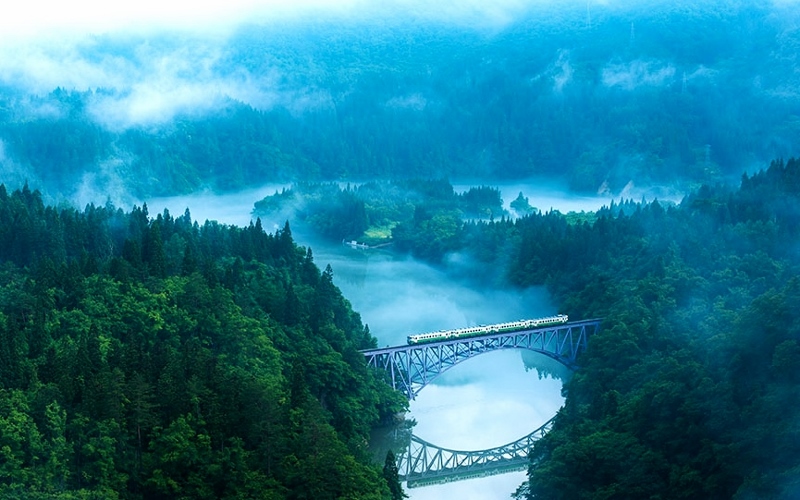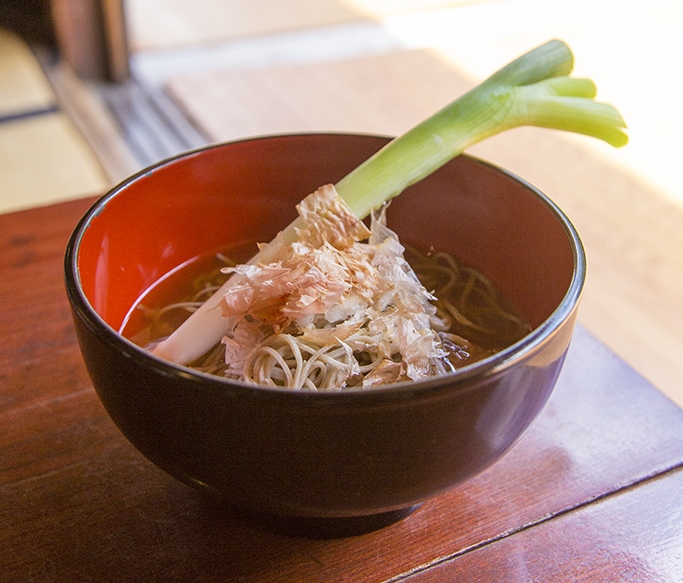Aizu’s iconic winter snapshots: the No. 1 Tadami River Bridge Viewpoint and more!

If you are a railway enthusiast, chances are that you have probably seen pictures of this magical scenery before: a green and white train crossing an arched metal bridge against a snowy white landscape, with the scenery reflected in the still waters below.
No. 1 Tadami River Bridge. (Video credit: JR East)
This is the No. 1 Tadami River Bridge (第一只見川橋梁 Dai-ichi Tadami-gawa Kyōryō), located in the western region of Aizu in Fukushima Prefecture. It is the type of place that leaves a lasting impression and makes you go, "I want to visit this place someday!"...or at least it did for me. After seeing numerous photos, mostly by photographer Kenko Hoshi, I decided that I would visit this picturesque area one day. In February 2020, I finally did!

Setting off bright and early at 6:00am from Aizu-Wakamatsu Station, I took a 90-minute ride on the JR Tadami Line (只見線) from JR Aizu-Wakamatsu Station (会津若松駅) to JR Aizu-Miyashita Station (会津宮下駅). From Aizu-Miyashita Station, it was a 10-minute bus ride to Michi-no-eki Mishima-juku (道の駅みしま宿), the closest roadside rest station to the No. 1 Tadami River Bridge Viewpoint. Here you can take shelter from the elements, go for a toilet break, and buy food and souvenirs. There is also space to park if you are coming by car.
The No. 1 Tadami River Bridge Viewpoint
Although there are many other stunning viewpoints of the Tadami River and its various bridges, the easiest to reach by public transport is the No. 1 Tadami River Bridge Viewpoint. The viewpoint is accessible all year round, but many would agree that winter provides the most breathtaking views.

Due to the warm winter this year, it was raining and there was not much accumulated snow, but the scenery was still amazing! After a short 5-minute walk up icy steps from Michi-no-eki Mishimajuku, you will reach Viewpoint B. There are three main viewpoints along the walking route, but the higher the better! Another 5 minutes takes you to the top (Viewpoint D), where you will be rewarded with a splendid view of the No. 1 Tadami River Bridge, the emerald waters of the Tadami River, and the surrounding mountains.

Infrequent trains pass the bridge in each direction about once every two to four hours. These were taken at 9:06am from the second viewpoint (left), and 9:18am from the top-most viewpoint (right). The bridge is located in between JR Aizu-Nishikata Station (会津西方駅) and JR Aizu-Hinohara Station (会津桧原駅), so you can see (and hear!) the train departing JR Aizu-Nishikata Station to the left of the bridge, and countdown until the train passes the bridge.

Most of the other travelers we saw were from Taiwan, excitedly checking their watches and the surroundings, and giving everyone else the heads up on when to get their shutters ready for the picture-perfect moment when the train crosses the bridge. But even without the trains passing the bridge, the views are still spectacular.

An informal survey board asking where visitors are from. (Image credit: JR East / Carissa Loh)
This place is slowly making a name for itself amongst international visitors, so there are many signs in English at the various train / bus stations. You do not need to worry about getting lost.

I highly recommend wearing sturdy shoes and spikes/crampons if you have them, as going down the steps was quite a feat! Ice covered all the steps, and you really needed to grab the chains and carefully totter down one step at a time. The nearby Michi-no-eki Mishima-juku has ice poles that are free to borrow, and boot rentals are also available for a small fee.

Only during winter, there is also a direct bus between JR Aizu-Wakamatsu Station and Michi-no-eki Mishimajuku. As trains are infrequent, we took the bus back to Aizu-Wakamatsu. The view along the JR Tadami Line is beautiful, so if you are like me and want more leg room and scenery, I recommend going by train and returning by bus. During other times of the year, I would recommend driving to visit other the scenic bridges and viewpoints as well, but in winter, icy conditions can make driving unsafe for travelers not used to winter roads. Thus, public transport is the way to go.
During the winter season (04 January–29 February for 2020), the direct bus between JR Aizu-Wakamatsu Station and Michi-no-eki Mishima-juku is operated by Aizu Bus and costs ¥1,200 per way, or ¥2,000 for a round trip. There is only one round trip per day in the morning:
- Outbound: 7:30 Aizu-Wakamatsu Station → 8:45 Michi-no-eki Mishima-juku
- Inbound: 9:40 Michi-no-eki Mishima-juku → 10:55 Aizu-Wakamatsu Station
Visiting in other seasons

Although it was only a short moment, the experience of being at a higher vantage point looking down at the scenery below was something unforgettable, and probably my favorite part of the trip. On the way back, I bought a calendar from Michi-no-eki Mishima-juku. It featured photos of various places along Tadami Line taken by photographer Kenko Hoshi. Someday, I will be back when there is more snow; and hopefully again during autumn, to see colourful scenery like the cover of the calendar.
Views of the Tadami River and its bridges in autumn. (Video credit: JR East)

No. 1 Tadami River Bridge in summer. (Image credit: 福島県観光物産交流協会)
And I'd like to visit maybe once again in spring, when greenery is abundant. No matter which season, you can count on the views to be stunning. If you have more time, there are many other spots along the Tadami Line from which you can get stunning views of the Tadami River and its many bridges.

View from the Kaneyama Fureai Hiroba Viewpoint. (Image credit: photoAC)
One such place is the Kaneyama Fureai Hiroba Viewpoint (かねやまふれあい広場), a short 800m walk from JR Aizu-Kawaguchi Station (会津川口駅). You can get a picturesque view of the train passing by the river, against a backdrop of the mountains. Along the riverbanks you can see a small village with colourful houses. How wonderful it must be to wake up to beautiful views of the river every morning!
Aizu-Wakamatsu City

Arriving back at Aizu-Wakamatsu at 10:55am and famished after braving the cold at the viewpoint, it was the perfect time for an early lunch. We tried two of the Aizu region’s specialties: sauce katsudon (ソースカツ丼 sōsu katsudon) and Kitakata ramen (喜多方ラーメン). Thumbs up for both, though I personally preferred the sauce katsudon for its very filling crispy pork katsu and tasty sauce.

Tsuruga Castle in winter. (Image credit: JR East / Carissa Loh)
Aizu-Wakamatsu city is a great place to base yourself for a few nights if you are planning to visit the rest of the region’s sights. After taking a trip to the No. 1 Tadami River Bridge Viewpoint in the morning, there is still ample time to explore Tsuruga Castle or the former post town of Ouchijuku in the afternoon.
Tsuruga Castle (鶴ヶ城 Tsurugajō) is a 20-minute bus ride from Aizu-Wakamatsu Station. Aizu-Wakamatsu is a former samurai castle town built around this unique castle featuring red roof tiles—it is the only castle in Japan to do so.
 Tsuruga Castle during cherry blossom season. (Image credit: 福島県観光物産交流協会)
Tsuruga Castle during cherry blossom season. (Image credit: 福島県観光物産交流協会)
Tsuruga Castle is also known for being one of Aizu Wakamatsu's best cherry blossom viewing spots. The castle's park has nearly 1,000 cherry blossom trees which bloom around mid to late April, and are illuminated in the evenings during the full bloom (満開 mankai) period.
Tsuruga Castle (鶴ヶ城)
Address: 1-1 Otemachi, Aizuwakamatsu, Fukushima 965-0873
Access: From Aizu-Wakamatsu Station (会津若松駅), take the loop bus (Haikara-san bus or Akabe bus) to Tsurugajo Kitaguchi bus stop and walk 5 minutes to the castle.

Painting an akabeko. (Image credit: 福島県観光物産交流協会)
After visiting the castle, head over to Tsurugajo Kaikan (鶴ヶ城会館), where you can try your hand at painting your own akabeko (赤べこ red cow), a traditional lucky charm of the Aizu region!
The post town of Ouchijuku

Ouchijuku in winter. (Image credit: JR East / Carissa Loh)
Ouchijuku (大内宿 Ōuchijuku) is a former post town along the Aizu-Nishi Kaido trade route. This area receives high snowfall in winter, and the town's old-style buildings have thick thatched roofs (茅葺屋根 kayabuki-yane) to guard against this. The scenery here is most stunning in winter, when the town is blanketed in thick, fluffy snow. Head up to the viewpoint for the best views, but beware: the steep steps might be slippery when covered with snow and ice so take caution when climbing.

A bowl of negi soba. (Image credit: 福島県観光物産交流協会)
You will find that some of the old buildings at Ouchijuku are restaurants and cafes, many of which serve a local specialty known as negi soba (ネギそば), soba noodles eaten with a big piece of negi (ネギ leek) as a spoon!

To get to Ouchijuku, take a 30-minute ride on the Aizu Railway Line (会津鉄道 Aizu Tetsudō) from Aizu-Wakamatsu Station (会津若松駅) to Yunokami Onsen Station (湯野上温泉駅). From there, take a 20-minute bus ride on a cool retro bus to Ouchijuku. At Yunokami Onsen Station there is a free footbath (足湯 ashiyu), so you can warm yourself up while waiting for the train.
Ouchijuku (大内宿)
Access: 20-minute bus ride from Aizu Railway Yunokami Onsen Station (湯野上温泉駅)
Admission fee: Free to enter the village and go up the viewpoint.
Getting there
JR Aizu-Wakamatsu Station (会津若松駅) is a 65-minute ride on the JR Ban'etsu West Line (磐越西線) from JR Kо̄riyama Station (郡山駅), which is 80 minutes by bullet train from JR Tо̄kyо̄ Station (東京駅).

The new JR EAST PASS (Tohoku area) and usage area. (Image credit: JR East)
If you are visiting the Tohoku region, check out the JR EAST PASS (Tohoku area), an affordable pass offering unlimited rail travel on JR East lines (including bullet trains) in the valid area for 5 consecutive days. At only ¥30,000, it makes for a great companion for rail travel around the region of Tohoku. The rail pass covers the Tadami Line, as well as the bullet train from Tokyo to Koriyama. Pass holders can also make seat reservations for bullet trains, some limited express trains and Joyful Trains online for free, up to 1 month in advance, on the JR-EAST Train Reservation.

The JR-EAST Train Reservation. (Image credit: JR East)
Header image credit: kenko hoshi / JNTO




